Lomo Ibérico with Alcaparras & Ñora Pepper
Everyone is going crazy for this 4-Ingredient tapas dish – Lomo Ibérico with Alcaparras & Ñora Pepper
Lomo Ibérico with Alcaparras & Ñora Pepper is a standout no-cook tapas recipe that uses a selection of premium ingredients to create a striking and flavorful dish. Thin slices of seasoned, tender Lomo Ibérico (Spanish pork loin) are arranged on a plate topped with alcaparras (Spanish giant capers). The dish is elevated with color and flavor by adding just a pinch of Ñora Pepper flakes and finished with a good drizzle of extra virgin olive oil.
Serve as a tapas, appetizer or as a striking party food dish, this easy-to-make tapas recipe comes together in around 5 minutes and serves 2.
This post may contain affiliate links.
Serving:
Tapas for 2
Ready in:
5 minutes
Skill level:
Easy
Serve with:
Bread
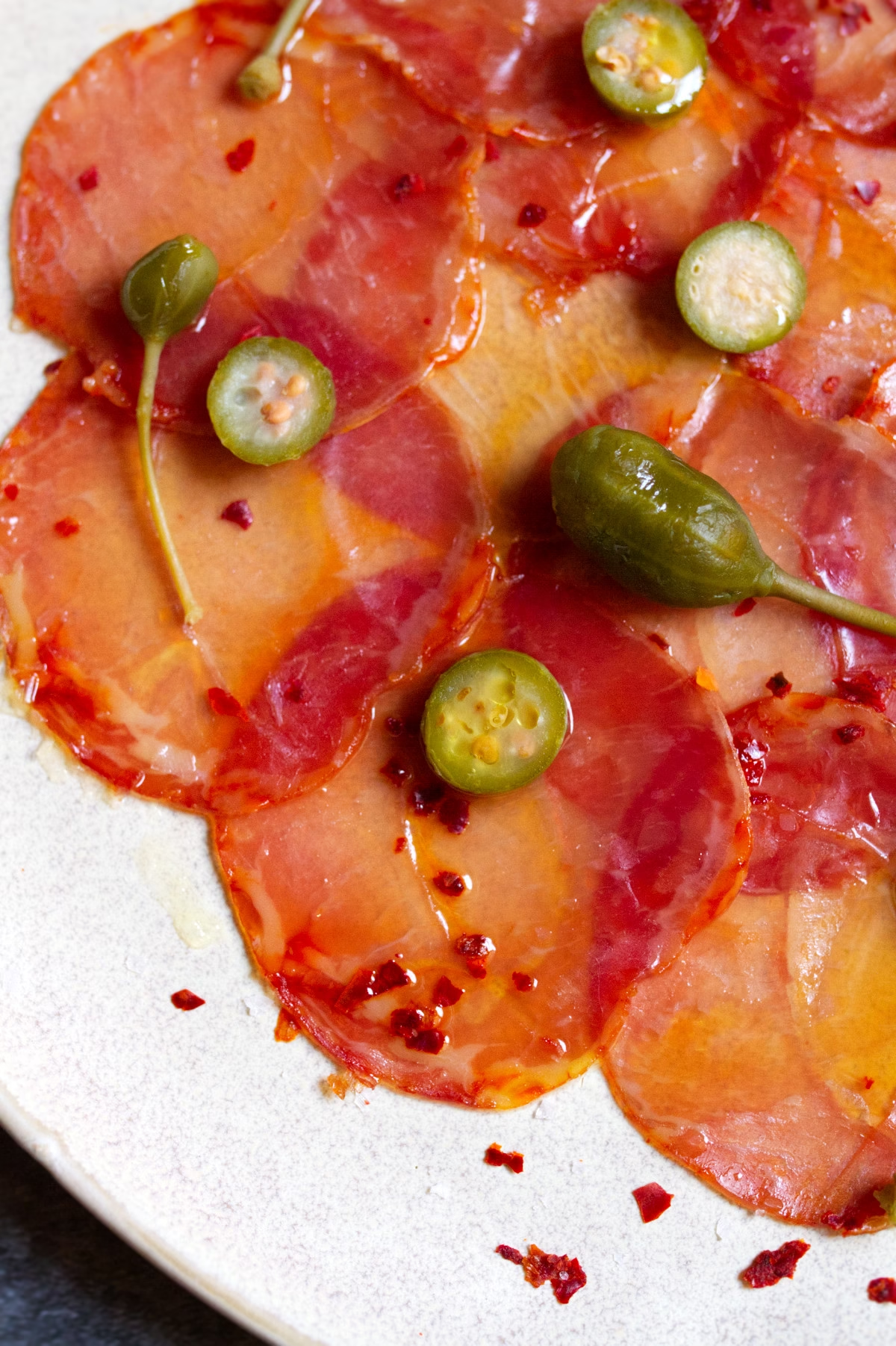
How to Make Lomo Ibérico with Alcaparras & Ñora Pepper
Ingredients
- 3.5 oz. (100g) Lomo Ibérico (pork loin)
- A few alcaparras (Giant Caper berries with stalks)
- A pinch of Ñora Pepper flakes
- A splash of Extra Virgin Olive Oil
- Salt and pepper (optional: to taste)
Equipment
Instructions
- Add thin slices of Lomo Ibérico to a serving platter.
- Slice a few alcaparras into disks and arrange on top of the Lomo Ibérico slices.
- Add a few whole alcaparras (with stalks still attached) for visual appeal.
- For some color, sprinkle with a pinch of Ñora Pepper flakes.
- Drizzle with olive oil and season to taste with salt and pepper.
- Serve alongside your favorite red wine (see recipe article below for our personal wine serving suggestions).
Inspiration for this recipe
In recent weeks, I’ve been experimenting a lot with different cured meats. My go-to cured meat has been ham, namely jamón Ibérico or Serrano ham, and I’ve been adding it to salads, veggies or fruits, or roasting it with veg or asparagus.
In keeping with the summer vibes, the recipe had to be no-cooking and ideally prepared with minimal fuss. I decided to take my research outside. After a quick perusal of the local charcuterie, I was told to try some good-quality lomo.
A few moments later, I had a small package of lomo Iberico in my kitchen and commenced with a little research on pairing it with another quintessentially Spanish ingredient – This for me, was a no-brainer – alcaparras (aka, capers).
Alcaparras are soft, tangy, and slightly floral berries that have a wonderful color and flavor. They work incredibly well with the saltiness of the lomo Ibérico, and simply for a little color and just a hint of extra flavor, I added some ñora pepper flakes.
I made this dish in a similar appearance to carpaccio dishes of Italy, and in true Mediterranean style, a drizzle of good-quality olive oil brings all the flavors together.
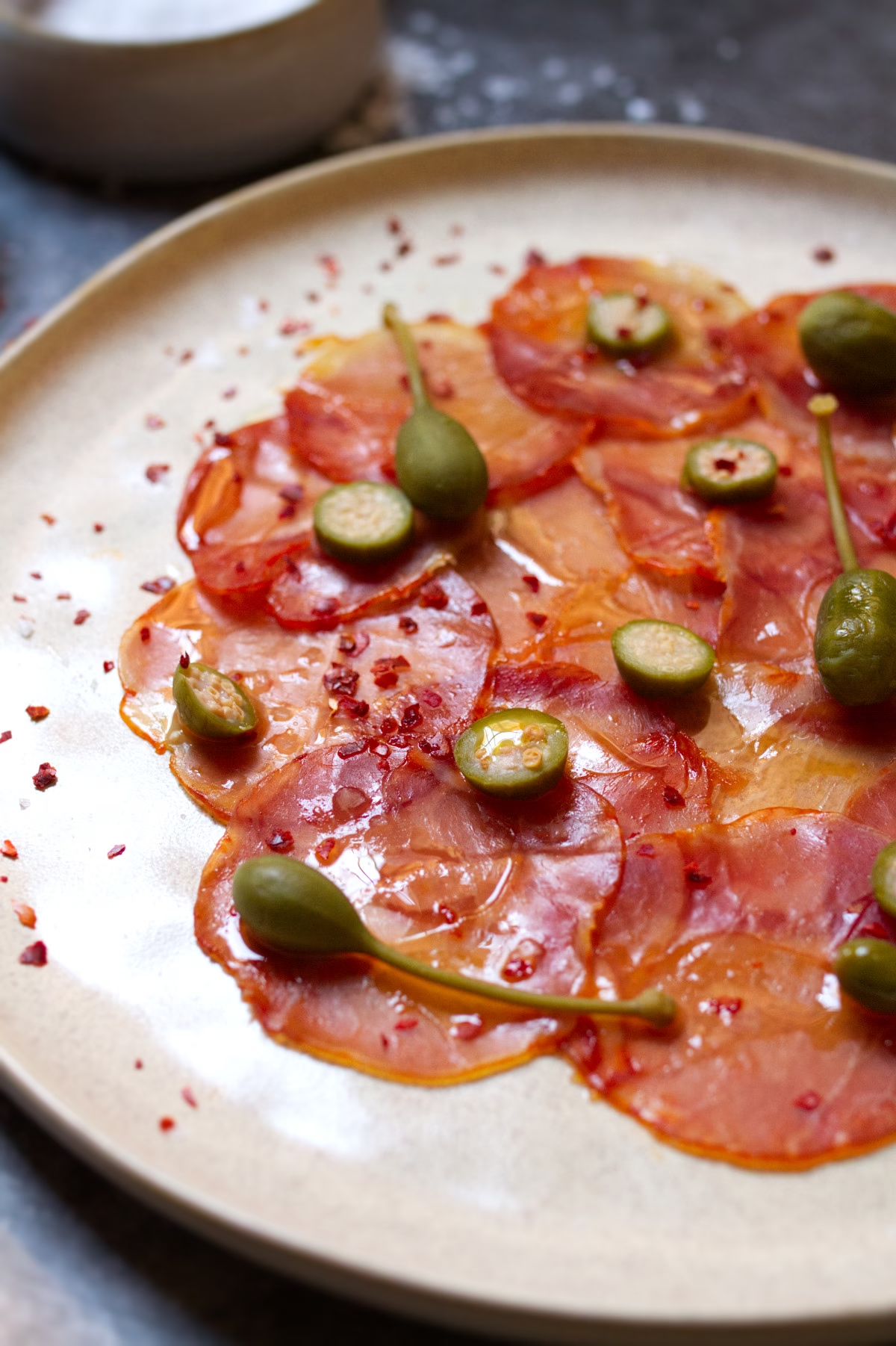
What is Lomo Ibérico
Lomo Ibérico is a traditional Spanish cured meat made from the loin of the Ibérico pig—a breed native to the Iberian Peninsula, famous for its rich, marbled meat.
Explore the Gastronomic Delights of Spanish Ham: Jamón Ibérico, Jamón Serrano, and Gran Reservas
Here’s the breakdown:
- Cut of meat: It comes from the loin (lomo), which is a lean, tender muscle along the pig’s back.
- Breed: The Ibérico pig is prized for its genetic predisposition to store intramuscular fat, giving the meat exceptional flavor and juiciness.
- Preparation: The loin is cleaned, seasoned with salt, paprika (pimentón), garlic, and other spices, then placed in a natural casing and cured for several weeks or months.
- Texture & flavor: Compared to jamón ibérico (from the hind leg), lomo ibérico is leaner but still flavorful, with a delicate, slightly smoky aroma and a balance of savory and sweet notes from the paprika and curing.
- Serving: Typically sliced very thin, eaten as part of a tapas spread, often accompanied by bread, manchego cheese, and wine.
In the context of Spanish cured meats, “de cebo” literally means “grain-fed” or “fattened with feed”.
When you see it on Ibérico products like lomo ibérico de cebo or jamón ibérico de cebo, it means:
- The pigs were raised on a diet of cereals and legumes, not primarily acorns.
- They were usually reared on farms (not free-range in the dehesa oak forests).
- It’s a lower grade than de bellota (acorn-fed) or de cebo de campo (mixed grazing + feed), but still from the Ibérico breed.
There are variations like Lomo Ibérico de Bellota—from pigs that are acorn-fed during the montanera season—which is considered the highest quality and most flavorful.
Lomo Ibérico Flavor profile
Lomo Ibérico has a flavor profile that’s rich but more refined than jamón ibérico, because it comes from the loin, which is leaner and has a smoother texture.
Here’s the typical tasting breakdown:
- Overall character: Delicate, savory, and aromatic rather than aggressively salty.
- Umami & meatiness: The Ibérico pig’s natural intramuscular fat melts easily on the palate, giving a lingering, buttery depth.
- Sweetness: A mild, natural sweetness from the pork itself, enhanced by curing.
- Spice notes: Paprika (pimentón), garlic, and oregano add warm, smoky, and herbal layers without overpowering the meat.
Differences by type:
- De bellota (acorn-fed) — nuttier, deeper, and more complex, with a silky mouthfeel.
- De cebo (grain-fed) — slightly milder and less nutty, more focused on the spiced cure.
We used the ‘Lomo De Cebo’ variety for this recipe. It’s got a great flavor and isn’t too expensive to buy. The pack we used from the Spanish brand Los Ibericos costs around €5.00 for 100 grams (3.5 oz).
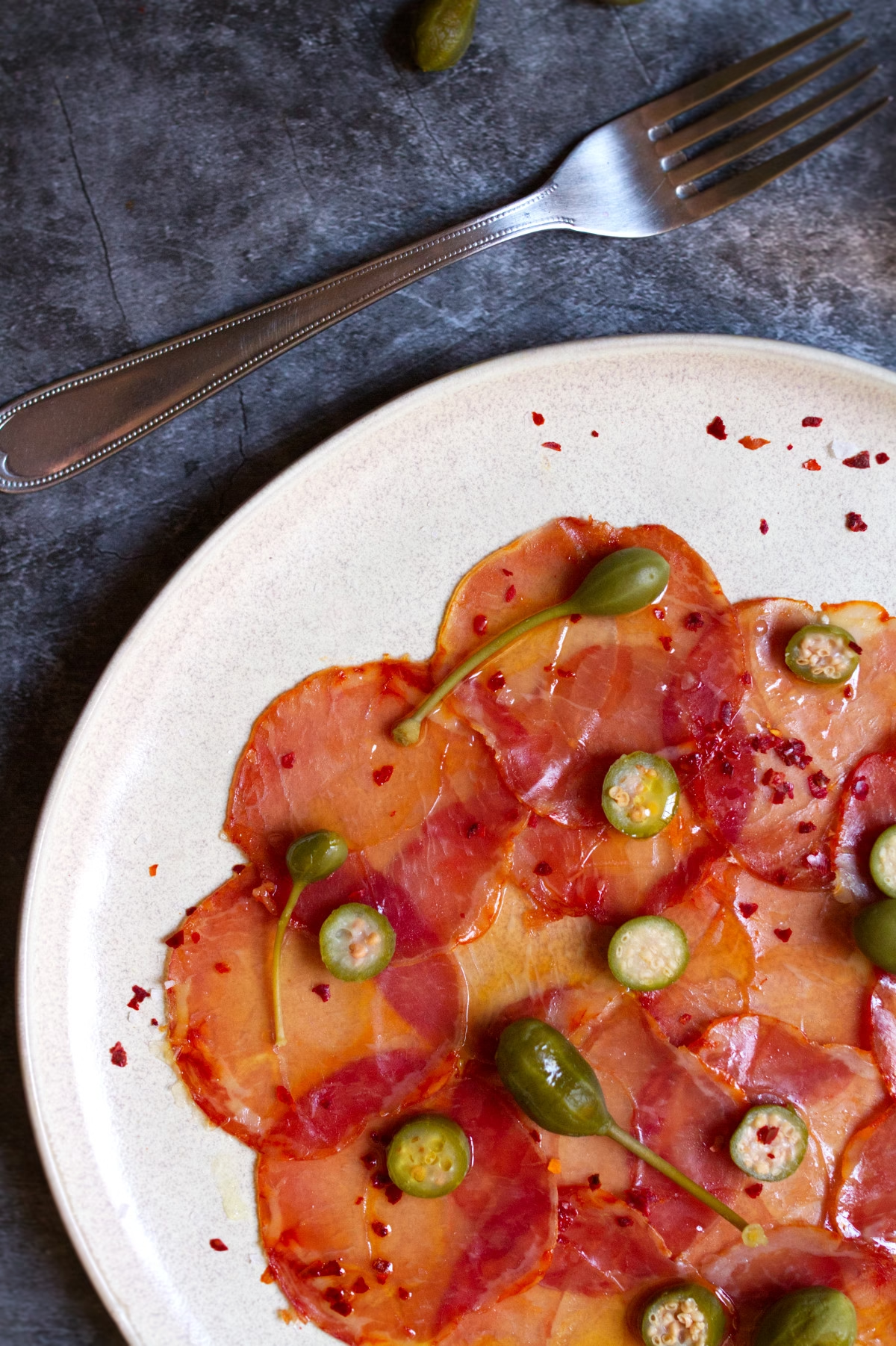
Where to buy Lomo Ibérico outside of Spain
Lomo Ibérico and Lomo de cebo Ibérico is usually purchased directly through any quality butcher or delicatessen that offers Mediterranean cold cuts. It can be a little tricky to source authentic Lomo Ibérico outside of Spain, however, there are a few good options for purchasing online with home delivery.
Note that for delivery, there are 2 main packaging types: Sliced and tubed (unsliced). We prefer the sliced version for convenience.
Sliced Lomo Ibérico
- Sliced Iberico de Bellota Pork Loin – 2 oz | 100% Acorn-Fed | Authentic Spanish Lomo
- Iberico Grain-Fed Loin Sliced 2 Oz // Lomo De Cebo Ibérico 2 Oz
- Fermin A Cut Above 50% Free Range Iberico Grain-Fed Loin ( Lomo de Cebo Iberico 50 % ) Sliced 2oz Pack
Tube of Lomo Ibérico
- Loin Lomo Iberico Bellota Cinco Jotas – 1 lb / 454 g – Free-Range Pork
- Lomo Iberico De Bellota Dry Cured Loin AX by COVAP
- Iberico Loin Tube Grain-Fed /Lomo de Cebo Ibérico 50% raza Ibérica (1 lb Average weight) by Fermin
Lomo Ibérico Substitutes
If you can’t get Lomo Ibérico, you can swap in other cured or fresh meats with similar texture, fat balance, and seasoning profile. Here are a few good examples from our neighbours in Italy.
For flavor & texture (thin-sliced charcuterie use)
- Lonzino (Italy) – Dry-cured pork loin seasoned with herbs and sometimes fennel; lean and delicately flavored, similar texture to lomo ibérico.
- Lomo Embuchado (non-Ibérico) – Spanish cured pork loin from standard white pigs; milder but similar seasoning.
- Capocollo / Coppa (Italy) – Cured pork neck/shoulder; more marbled than lomo but with rich, spiced flavors.
- Culatello di Zibello (Italy) – Cured pork muscle from the thigh; silkier and slightly sweeter, but works in tapas.

What are Alcaparras
Alcaparras are simply capers in Spanish. They’re also known as Giant caper berries in other parts of the world.
They’re the small, green, pickled flower buds of the Capparis spinosa plant, typically preserved in brine or vinegar. They usually come packaged in jars or cans and will often have their long stem still attached. Alcaparras are a staple in any Spanish pantry and are usually found in the canned goods aisle of any supermarket (look next to the olives).
Key points:
- Flavor: Salty, tangy, slightly floral, with a concentrated burst of umami.
- Uses: Common in Mediterranean, Spanish, and Latin American cooking—added to sauces (salsa puttanesca), salads, fish dishes, or as a garnish for meats.
- Size note: Smaller capers tend to be more delicate in texture and flavor; larger ones (sometimes called alcaparrones, actually the pickled fruit) are milder but more robust in bite.
In Spanish cooking, you’ll see them in recipes like pollo alcaparrado, ensaladilla rusa, or as a tangy counterpoint in tapas plates.
More recipes that feature alcaparras
- Baked Cod with Tomatoes, Chickpeas, and Capers
- Spanish Chicken in Creamy Mustard Sauce – Pollo a la Mostaza
- Tomato, Ham, and Onion salad – Ensalada de tomate con jamón
- Mediterranean-Chickpea-Tuna-Salad Recipe
- Chickpea and Caper Salad with Charred Red Peppers (Garbanzos Alinados con Alcaparras)
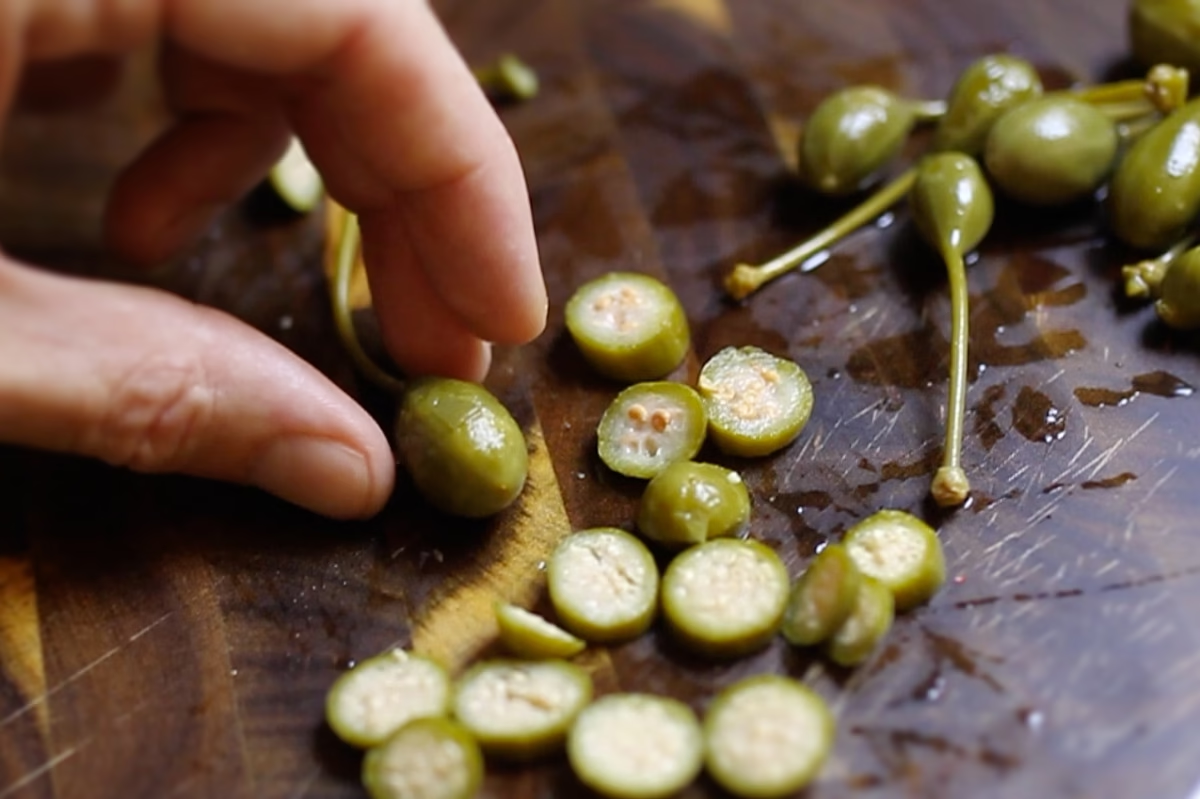
Where to buy alcaparras (inside and outside of Spain)
Here in Spain, alcaparras are super easy to source, and you’ll easily find a selection of brands in any good supermarket. Look for alcaparras in the canned goods isle, usually next to olives, pickles, and other pickled veg.
Outside of Spain, you’ll be best to find alcaparras by their Western name, Giant caper berries. They’re not too hard to find, and any half-decent Mediterranean food store will stock them. They’re also a common ingredient in Latin American cooking, so it’s also worth checking out Latin American food stores.
Online is also another great place to buy alcaparras (even Whole Foods packages their own brand), here are a few reliable brands, both from Spain and/or Italy:
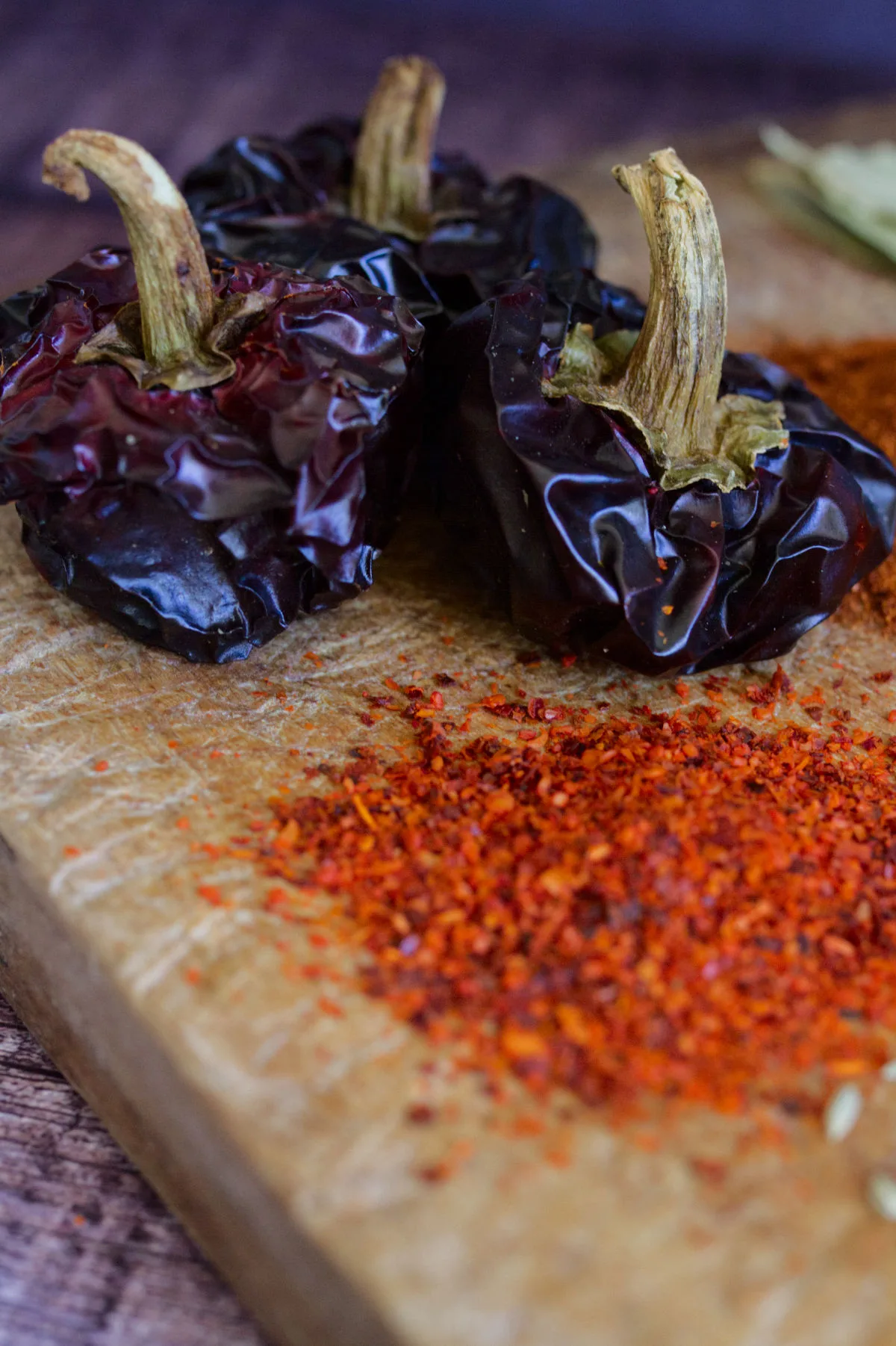
What are Ñora Peppers
Ñora peppers are small, round, sweet red peppers from Spain, particularly associated with the Murcia and Valencia regions. They’re prized for adding flavor and color to dishes, and are used in many of Spain’s most famous dishes. Ñoras are like the sweet, round, Spanish cousin of chili peppers—there for flavor and color, not for heat.
Key details:
- Appearance: About the size of a golf ball, ñora peppers turn deep red to burgundy color when dried, with a wrinkled skin.
- Flavor: Sweet, earthy, and slightly smoky, but not spicy. They give dishes depth and a gentle sweetness without heat.
- Use: Usually sold dried; the skin is tough, so they’re often soaked in warm water and the flesh is scraped out to make pastes or added to sauces.
- Culinary role: A key ingredient in many traditional Spanish recipes—especially sofrito sauces, paella, fideuà, and some even add ñora peppers to romesco sauce.
- Relation to paprika: While they’re different from pimentón (Spanish paprika), pimentón is traditionally made from peppers of the same variety or closely related ones.
Where to buy Ñora Peppers outside of Spain
Ñora peppers are exported all over the world, either packaged dried and whole or dried flakes. Here are a few brands you can buy online:
Nutrition Facts (Per Serving)
|
Nutrient |
Amount |
% Daily Value |
|
Calories |
~(109 kcal from pork) + ~(12 kcal from EVOO) + negligible from caper berries & Ñora |
~121 kcal (~6%) |
|
Total Fat |
~2.2 g (pork) + ~1.4 g (olive oil) + minimal from capers |
~3.6 g (~5%) |
|
– Saturated Fat |
~0.6 g (estimated) |
~3% |
|
Protein |
~21 g (pork) + ~0.1 g (capers) |
~21 g (~42%) |
|
Carbohydrates |
~0 g |
0% |
|
Sodium |
Minimal (caper berries small qty, ~20 mg) |
~1% |
|
Vitamin K / Copper |
Trace from capers |
— |
|
Total Calories |
~121 kcal |
~6% DV |
Ingredient Breakdown
- Pork Loin (Lomo Ibérico), raw lean:
Based on USDA figures for pork loin tenderloin/raw — 109 kcal, 2.17 g fat, 0 g carbs, ~106 g protein per 100 g
Adjusted to more standard figures: ~109 kcal, 2.2 g fat, 21 g protein per 100 g — - Extra Virgin Olive Oil (splash ≈ 1 tsp ≈ 4.5 g):
Approx. 40 kcal, 4.5 g fat. Only half counted per serving: ~12 kcal, 1.4 g fat. - Caper Berries (“a few”):
Small serving (~1 tbsp) contributes minimal calories (~2–3 kcal), negligible macro–nutrients; sodium ~20 mg - Ñora Pepper flakes (pinch): Negligible nutritional impact.

Lomo Ibérico with Alcaparras & Ñora Pepper 🫶🏻🇪🇸
Equipment
- Serving platter
- Wooden cutting board
- Chef knife
Ingredients
- 3.5 oz. 100g Lomo Ibérico (pork loin)
- A few alcaparras Giant Caper berries with stalks
- A pinch of Ñora Pepper flakes
- A splash of Extra Virgin Olive Oil
- Salt and pepper optional: to taste
Instructions
- Add thin slices of Lomo Ibérico to a serving platter.3.5 oz. 100g Lomo Ibérico (pork loin)
- Slice a few alcaparras into disks and arrange on top of the Lomo Ibérico slices.A few alcaparras
- Add a few whole alcaparras (with stalks still attached) for visual appeal.
- For some color, sprinkle with a pinch of Ñora Pepper flakes.A pinch of Ñora Pepper flakes
- Drizzle with olive oil and season to taste with salt and pepper.A splash of Extra Virgin Olive Oil, Salt and pepper
- Serve alongside your favorite red wine
Video
Love this recipe?
Leave us a comment and tell us your favorite Spanish recipe!


0 Comments